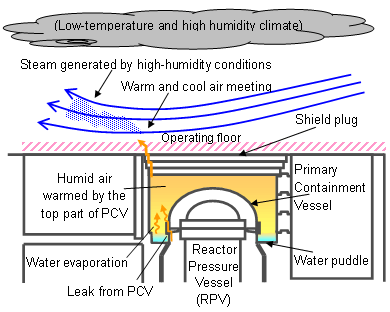Top > Releases ・ Announcements > Announcements > 2014 > Regarding Certain Overseas Reports on Fukushima Daiichi Nuclear Power Station
Some overseas press outlets are reporting that steam is being generated from Unit 3 at Fukushima Daiichi NPS and its condition is dangerous, releasing radioactive material, and that there were two underground nuclear explosions at the site. However, such information is incorrect, and we have found no change in the status of the plant.
Steam generation on the operating floor at Unit 3, and the detection of highly concentrated radioactive material at groundwater observation holes etc., have been pointed out as the basis for the overseas reports. We respond to these as follows.
- Steam-like gas generated on the operating floor at Unit 3 in Fukushima Daiichi NPS
Since July 2013, steam-like gas has been intermittently observed on the operating floor at Unit 3. The steam-like gas is estimated to emerge via the following sequence.
1) Accumulated hygroscopic moisture, such as rainwater, exists below the shield plug (a lid made of concrete).
2) The hygroscopic moisture is heated by the heat radiated from the top of the Primary Containment Vessel (PCV).
3) The heated hygroscopic moisture is released onto the operating floor via the gap of the shield plug.
4) The released moisture is cooled down by the cool atmosphere, giving it the appearance of a steam-like gas.
We found no abnormalities in the measured values (indicating the temperature and condition of the Reactor Building), or in the value of the monitoring post (monitoring the amount of radiation), even when the steam-like gas was being generated, therefore we are certain that there has been no influence on the outside.
In addition, we measured the amount of radiation at the point from which steam-like gas was generated, and found that its amount was almost the same as for the other neighboring points.

- Highly-concentrated radioactive material found at the observation holes
We have been monitoring the groundwater sampled at the observation holes established to investigate the contamination status of groundwater, for the purpose of investigating the effects of the leak of contaminated water from the contaminated water storage tanks in August 2013. At the end of 2013, the measurement value for Tritium, one of the radioactive materials in the water sampled at the observation hole near the tank that suffered leakage, increased from 34,000Bq/L (on December 28) to 450,000Bq/L (on January 1). This increase in the value could be attributed to 1) the contaminated water that previously leaked from the tank soaking into the nearby ground, or 2) the effects of the water pumping* (*we have been pumping up the contaminated groundwater at the nearby observation holes, however the amount being pumped up was temporarily decreased at the end of 2013). The value decreased to 17,000Bq/L on January 8. Highly concentrated tritium (almost equivalent concentration level) was found in this observation hole in the past, and the highest concentrated tritium 790,000Bq/L was also found here on October 17, 2013.
- Earthquake on December 31, 2013
Some overseas press outlets reported that underground nuclear explosions caused several quakes with magnitudes of 5.1 and 3.6.
According to the Japanese Meteorological Agency, 13 earthquakes (with a maximum magnitude of 5.4) occurred and originated in the north part of Ibaraki Prefecture on December 31 2013. None of these earthquakes was caused by Fukushima Daiichi NPS. We also found no accidents or trouble etc. in Fukushima Daiichi NPS.
© Tokyo Electric Power Company Holdings, Inc.